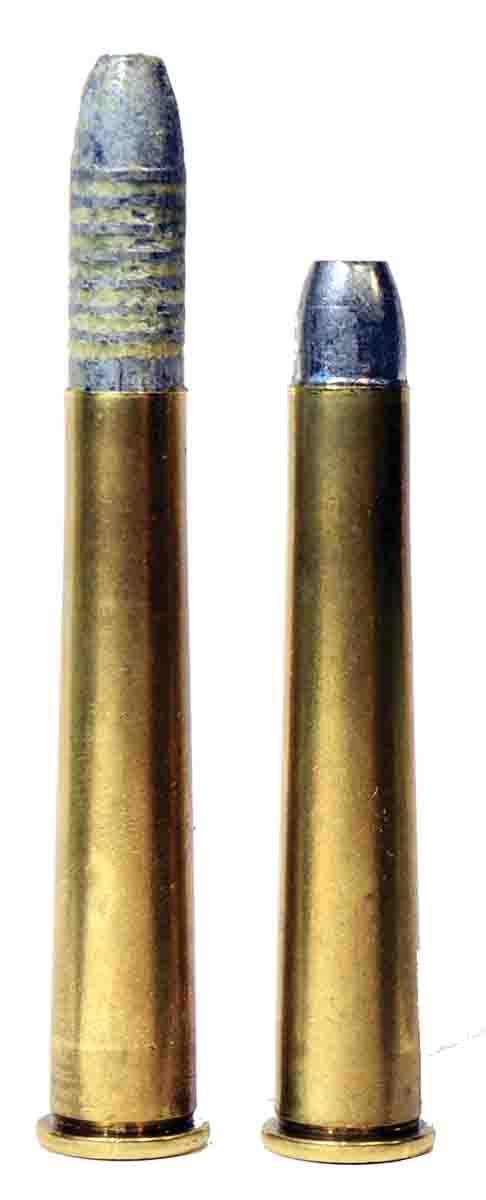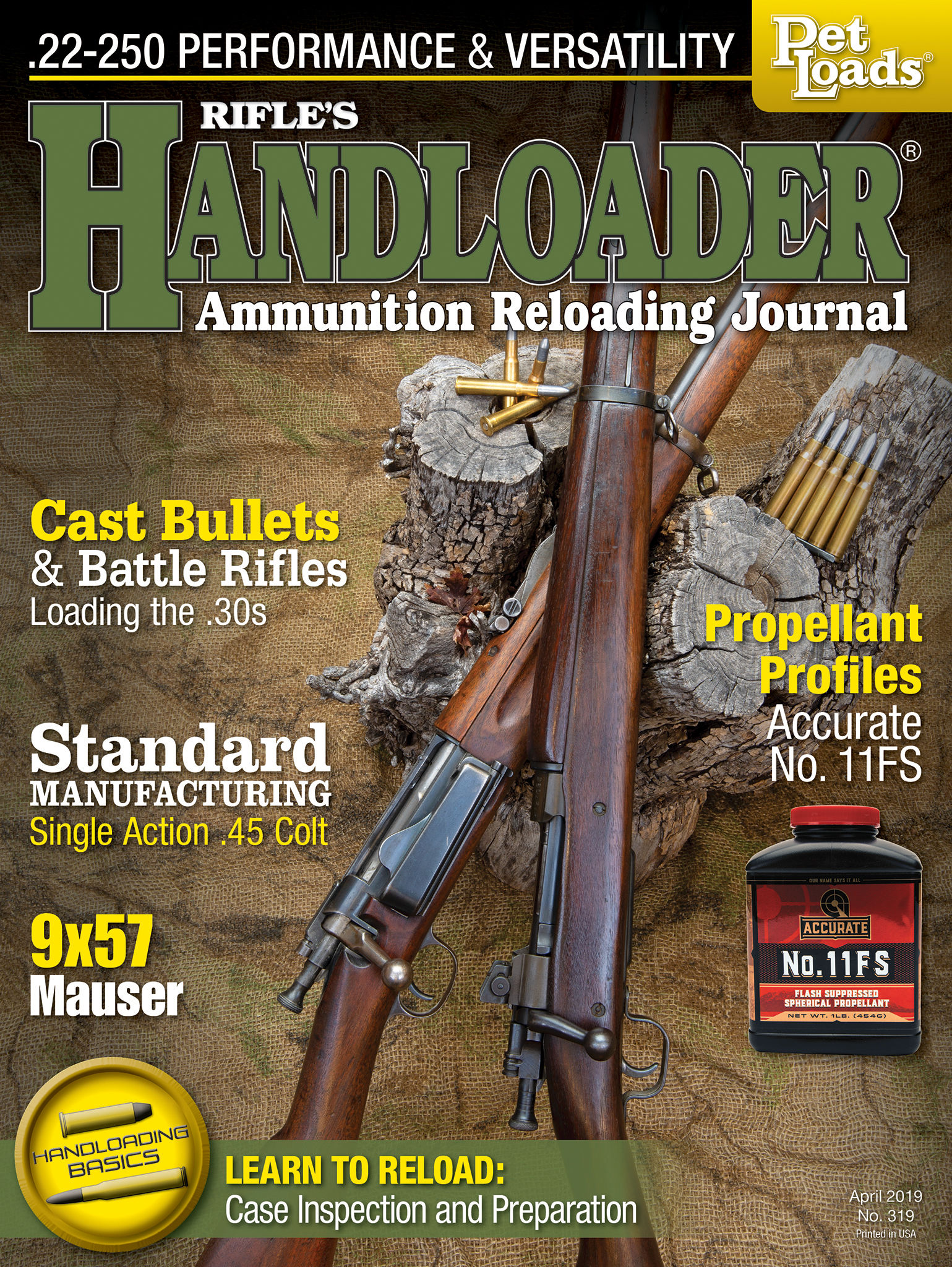In Range
Marks and Measures
column By: Terry Wieland | April, 19
In 1901, C.W. Rowland of Boulder, Colorado, fired one of the most famous accuracy groups in history: ten shots, 200 yards, .721 inch. Fifty years later, this benchrest record still stood. Given the advances made in measuring equipment in the intervening half century, it’s not surprising that some shooters called for the group to be certified using modern methods.
According to Gerald O. Kelver’s Schuetzen Rifles – History and Loadings (1972), the original measurement was confirmed. Since modern benchrest shooting was just getting underway in the early 1950s – it was formalized in 1949 – Rowland’s record gave everyone a standard against which to measure themselves.
If any of these facts and figures are not quite exact, I apologize. There is all kinds of conflicting information floating about, and I

At the time Rowland shot the group, his accomplishment was widely reported, because rifle shooting of all kinds enjoyed tremendous popular interest. Periodicals reported everything they could find out about Rowland, his rifle, his cartridge, how he cast his bullets, the lubricant used and how much of what powder was used. I use “find out” because it was unlikely a competitor like C.W. Rowland would reveal all his secrets.
The rifle, known as the Rowland-Pope, was custom built by Harry Pope using one of his barrels on a Ballard action. The caliber is .32-40, and it has a very long, very heavy barrel with a false muzzle. The 20x scope is almost as long as the barrel.
The more one delves into different loading methods of a century ago, the more confusing it becomes. The transition from black powder to smokeless, coming hard on the heels of the transition from muzzleloading to breechloading, spawned such a wide variety of methods that it’s hard to know where to begin.
Today, reloading ammunition for even the most demanding level of benchrest shooting is relatively simple compared to 120 years ago. Modern brass is good, and standardized; bullets are a known quantity; primers are uniformly excellent, and we have more top-notch powders available than ever before in history. It’s merely a matter of finding the right combination. Chances are it would be harder to find a combination that shoots really badly than to find one that performs well.
All the things handloaders take for granted, such as uniform case weight and concentricity of chamber, bore and cartridge case, were largely unknown in 1901.
The best match bullets of that time were cast from a lead alloy, and it was generally conceded that, with black powder at least, the best accuracy was obtained by loading the bullet from the muzzle so as to ensure the base suffered the least distortion. Beyond that, the variations and permutations were almost infinite.
After deciding on caliber, there was bullet weight, shape and alloy; paper-patched or lubricated and, if the latter, what to use for lubrication. As for powder, it could be black, semi-smokeless, smokeless or a duplex combination of them. Even the method of getting the bullet into position to fire was not as simple as seating it in a case to a certain depth, then loading it into the chamber.
For many years I read that best accuracy was obtained by seating the bullet in the cartridge to almost, but not quite, brush the lands of the rifling. Having it actually press against the rifling was frowned upon because it raised pressures. Exact measurements were figured out by measuring the depth from the muzzle to the tip of a bullet, pressed up against the rifling from the rear, and subtracting that from the depth from muzzle to bolt face. That gave maximum cartridge length, and you then backed off .01 inch or so.
To a rifleman in 1901, that would have seemed both over-simplified and inexact. Some shooters used Harry Pope’s breech-muzzle approach, pushing the bullet down the bore, then placing a cartridge case with powder and primer in the chamber. Others seated the bullet into the rifling from the breech, then chambered the cartridge case behind it with the mouth of the case touching the base of the bullet.
An alternative was to size case necks to be snug but not tight, seat the bullet well out in the neck and then allow it to be pushed deeper into the case as the breech was closed. This ensured a tight fit everywhere and, assuming a good rifle with proper concentricity, an accurate shot.
Some enthusiasts designed bullets with different diameters front and back, had moulds made to cast them and then had their rifles custom-throated to accept these bullets loaded from the breech. W.G. Hudson was one such person, and Lyman moulds for Hudson bullets were available for many years. Normally, there were no markings on the rifle to indicate the nonstandard chamber and throat, and if one of these rifles is found, getting it to shoot can be an adventure.
The transition from black powder to smokeless caused several problems. Black-powder ignition causes soft lead bullets to “bump up” in diameter to fit the rifling; smokeless does not. To load a bullet from the muzzle, it must be soft, because a hard alloy is difficult to push down the barrel. If using an undersized bullet, expecting it to bump up in diameter, smokeless won’t do it.
All kinds of different approaches were tried. Some shooters used black powder but put in a few grains of smokeless next to the primer. This bumped the bullet and burned cleaner. Others used the reverse approach, with a few grains of black as a primer and smokeless as the main charge. Still others used fine-grain black (FFFFg, for example) in a small charge ahead of the primer, with the case filled with Fg or FFg.
Some adventurous souls experimented with a combination of breech- and muzzle-loading, placing a primed case in the chamber then filling it with black powder poured down the barrel. Naturally, they put in as much as they wanted then seated a bullet from the muzzle. Sometimes, the powder charge extended well into the rifling.
Because smokeless powder is much less bulky than black, using it in cases designed for black powder presented its own problems. Some shooters used wads to hold the powder in place; others simply elevated the muzzle to settle the powder against the primer before shooting. This supposedly ensured consistent ignition. A few shooters disagreed, believing that such an approach blew the powder granules forward and embedded some in the base of the bullet, making it unbalanced. Their approach was to lower the muzzle instead, so the powder would pile up against the bullet. Everyone agreed, apparently, that it had to be one or the other – that the powder’s position had to be consistent from shot to shot – but I have never found anything definitive pointing to one or the other as superior.
C.W. Rowland’s .721-inch group from 1901 was fired using a Pope- Ballard muzzle-breechloader. Somewhere, I am sure, there is a report on what powder he used, or what combination thereof, and if it was smokeless, whether he preferred the charge to be up against the primer or against the base of the bullet. Whatever it was, it obviously worked.
But Rowland was a competitor, and his shooting was done in competition with other shooters of comparable ability. Would he have revealed every arcane detail of how he achieved the level of accuracy he did, or would he have kept some of those details to himself? The debate has ebbed and flowed ever since, and we will probably never know for sure. Perhaps it’s enough just to know that it can be done. It gives us all something – pardon the pun – to shoot for.


